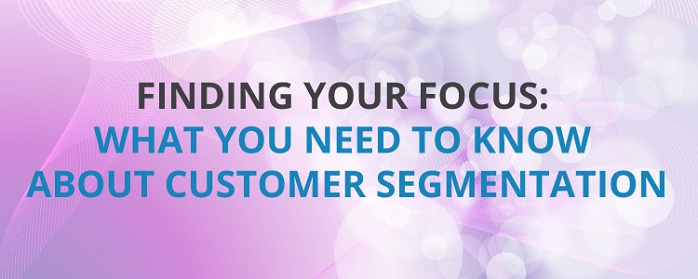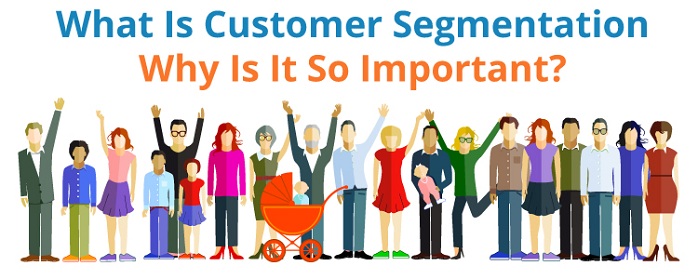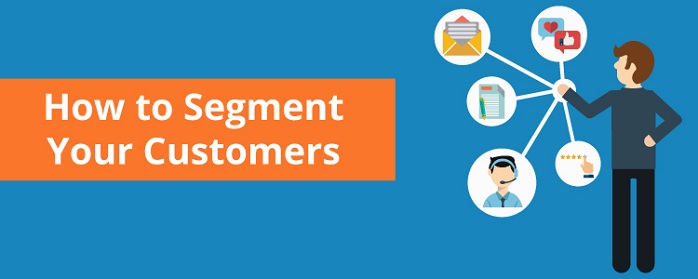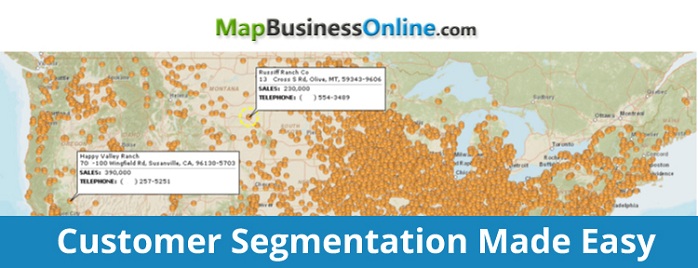Finding Your Focus: What You Need to Know About Customer Segmentation

According to Harvard Business School professor Clayton Christensen, as many as 95 percent of annual product launches fail — and most of these failures are due to poor market segmentation.

Does that figure ring any alarm bells? It should. Any business owner will attest to the importance, and even necessity, of well-designed marketing efforts. But exactly what this means is not always obvious. After all, marketing is a highly intricate process, often more of an art than a science. And understanding the effectiveness of your actions is a serious undertaking in its own right.
There is one marketing practice that’s perhaps more essential than any when it comes to achieving optimal results, and it has the additional benefit of helping you to analyze why your efforts are or aren’t working. We’re speaking, of course, about customer segmentation.

What Is Customer Segmentation, and Why Is It So Important?
At its most basic, customer segmentation is the act of splitting your customers — and your prospects — into various groups. These groups are called “segments,” and they are a key piece in any successful marketing strategy. Each segment should have some characteristics, or “demographics,” that are common to every member within it, characteristics that influence their buying habits.
It’s not practical to tailor marketing campaigns to each individual customer of interest, but neither is it wise to attempt a “one-size-fits-all” approach. You may achieve a certain level of results through mass marketing, which tends to assume all of your customers are the same, but it’s ultimately not an efficient process. And staying competitive in the cutthroat world of business is all about efficiency in operations.
This is where segmentation really shines. By dividing your extensive base of prospective and current customers into smaller subgroups with shared characteristics, you should find it easier to deliver messages that speak to them on a more personal level. This, in turn, saves you considerable effort and resources in the long run, and leads to more conversions almost immediately. It’s also a great way to develop a better understanding of your clientele, which will pay dividends for many years to come.
Customer segmentation does not need to be complex, but it does need to be done. Smaller organizations, or even just those offering one or two highly specialized services, may only have two or three distinct types of customers. What is relevant is not necessarily surface differences between your buyers but the specific differences that influence their purchasing habits.
If smart customer profile methods are used, customer segmentation can massively improve the effectiveness of your marketing efforts. But when done poorly, it’s at best a waste of your time, money and energy — and at worst, misleading enough to seriously impair your operations. So what are the optimal ways to segment customers?

How to Segment Your Customers
There are countless potential segments to choose from, but only a select few will truly fit your unique client base. And therein lies the trick of customer segmentation: building the most accurate customer profiles and understanding why these groups look, or should look, to your products or services.
As with any major marketing endeavor, organization and planning is key. Begin with a list of your current customer base, including as much relevant detail as possible. Business mapping software makes it simple to organize your existing clients electronically and generate relevant reports. Business mapping software is a wise investment if you haven’t already invested in such a service. Success here is largely dependent on how well you know your customers and their behavior patterns, so be sure you’ve done some market research in advance.
Next, it’s time to take a closer look at your customers’ basic characteristics. Why do customers buy your product or service, or why might they in the near future? Presumably they do it because it meets one or more of their “needs” or “wants.” And both needs and wants are related to customer demographics.
How to Create a Customer Profile
Traditionally, some of the most frequently used demographics in marketing include:
- Age: Everything from television shows to clothing brands to political messages are targeted based on the customer’s age. Every age group has different concerns and priorities, and smart marketers use this to tailor their advertising campaigns. This number also tends to inform some other demographic factors to a certain degree: an older populace, for instance, will often have an above-average spending power and may be more likely to be married.
- Gender: Males and females often have needs and wants that differ wildly from one another, and you don’t even have to be a marketing hotshot to see why this matters. Gender also influences media consumption habits. Did you know, for instance, that the percentage of women using social media is higher than that of men? Paying attention to how your customers identify themselves will help you to create better-targeted advertising campaigns.

- Marital status: The single man or woman usually lives a very different lifestyle than the one with a spouse and/or children. They often have more disposable income and may be inclined to make purchases for luxury over practicality. Marketing big items, such as vehicles and housing, to a married couple might mean selling both parties on the merits of your product. And, of course, those with big families are often far more interested in bulk consumer goods than those without.
- Location: Anything that varies from place to place, such as population density, ethnic majority or climate, is a potentially significant factor in customer segmentation. When looking at location, there is no inherently right or wrong scale to use. Some businesses will be interested in the various states or countries that purchase their services, while others may find it more helpful to compare individual neighborhoods against one another.
- Education level: A customer’s highest-achieved level of education tends to influence their purchasing decisions as well as their ability to utilize a certain product or service. Some industries — publishing, for instance — will be very concerned with this demographic as a way of classifying their markets, while the value might be less obvious for other industries.
Even so, education is linked to perceived “social class,” and simply holding an advanced degree can easily impact the way a customer thinks about themselves. That will guide their shopping habits in turn.
- Income level: This is easily one of the most important demographics for customer segmentation. Your customer’s income doesn’t just represent a maximum amount they could have available to spend. It will actually give you insight into their purchasing patterns.
For instance, those with high incomes may look for products and services that are presented as “luxury” options, regardless of the actual number on the attached price tag. Likewise, those with particularly low levels of income may be quickly put off by anything that carries an image of exorbitance, even if it could theoretically fit into their budget. - Language: What language or languages does your customer speak? For many businesses, the answer will be simply “English,” and this category won’t be terribly interesting. But if your customer base includes native speakers of multiple different languages, it can be highly beneficial to develop marketing materials that speak to their cultural differences and frame your product or service in an appropriate light.
The Right Target Customer Profile
Of course, that is not to say each of these demographics will necessarily be relevant for your specific needs. Nor is the list comprehensive by any means. Paint a picture of the typical user for each product or service you offer. What qualities are consistent across your customer base? What characteristics influence their desire to buy your product?
Whatever the answer, these are the characteristics around which your segments should be constructed. And remember not all segments need to be equal in value. It is entirely possible one group will represent your most lucrative customer base, while another will represent those infrequent buyers with comparatively little need for your services.
In fact, a common and simple approach in marketing is to do just that. Divide your customer base into a number of groups based on the current level of revenue and engagement they offer. In this way, you can reach out to potential future customers in one fashion, while not wasting any resources and effort to convince those who are already sold on your offerings and simply need to be kept in the loop on news and announcements.
You may even wish to create this set of subgroups for each one of your products or services. If you’ve ever signed up for another company’s news mailing list, only to learn they have separate, product-specific mailing lists as well, you’ve seen this kind of segmentation in action. Do be sure, in any event, that any segments you create are valuable enough to market to at all. You can check the customer’s anticipated value against the cost of your marketing efforts to determine whether it’s worth your while.
The Smartest Ways to Segment Customers
No matter how you choose to segment your customer base, it’s important be selective with the demographics you consider. Your segments should contain the minimal number of qualifiers to catch every one of your potential users or clientele, without lumping any customer into multiple groups. If you are hitting the same individuals with targeted advertisements from several different directions, it’s entirely possible to exhaust their interest in what you have to offer.
The flexibility allowed in customer segmentation can make it tricky to know what the best approach is, but this can also be its greatest strength. Your ideal segments could easily be ones your competitors haven’t yet identified, giving your subsequent marketing efforts and profits a dramatic boost.

A recent survey conducted by B2B International found a mere 42 percent of U.S.-based B2B companies used a sophisticated approach to customer segmentation, or one with refined and detailed demographic research. This need not be the case: in Germany, that figure is over 60 percent. But don’t let the hopeless pursuit of perfection keep you from taking action today. Even basic segmentation into broad categories such as “customer” and “prospect” are a great first step toward more relevant messages and higher conversion counts.

Reaching Your Customer Base
Once you’ve developed a comprehensive set of segments that contain each of your relevant target customer profiles, the next step is putting them to work for you. And to do that, you’ll need to take a close look at each of the segments you’ve come up with.
Once you’ve developed a comprehensive set of segments that contain each of your relevant target customer profiles, the next step is putting them to work for you. And to do that, you’ll need to take a close look at each of the segments you’ve come up with.
- Benefits: Do your products or services fully satisfy the specific needs/desires of your customer base?
- Price: Are your products or services seen as cost-effective and competitively priced?
- Accessibility: Do customers feel your products or services are easy to obtain?
- Promotion: Are your marketing efforts being sent out along the best and most relevant media channels?

Be tough but fair in your analysis of these questions. A simple “yes” response to one or more of these questions could indicate at least one aspect of your current approach is working optimally. But if there is room for improvement in any of your answers, that’s great as well. It means you’ve identified a better way to reach your customers and meet their needs. And that’s really what market segmentation is all about.
MapBusinessOnline – Customer Segmentation Made Easy
Ready to take your customer segmentation efforts to the next level? Look no further than www.MapBusinessOnline.com, America’s fastest-growing business mapping software. Our intuitive cloud-based business mapping tools help your organization to design and image customer demographics and sales territories. Build fast map visualizations of your existing business records, share them with your team, and perform immediate market analysis as never before. You can even compare your own collected data against U.S. Census demographic data. You’ll be amazed at the insight a map adds to your customer address list. Get segmenting using map tools today.

MapBusinessOnline runs entirely through your web browser, so it’s compatible with both Windows and Mac, accessible from anywhere, and doesn’t require a beefy computer setup. Our extensive collection of text- and video-based tutorials will help you to hit the ground running. And thanks to our simple-to-use online support and optional training services, we’ll be there to assist as necessary.
If you have a question, contact our team so that you can start using our business mapping tools today!
Why wait any longer to better serve your customer base? Start your 1-month free trial today — no credit card required.



